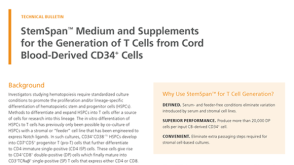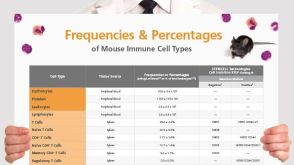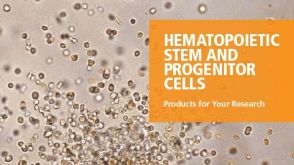技术资料
-
 技术公告StemSpan™ Medium and Supplements for the Generation of T Cells from Cord Blood-Derived CD34+ Cells
技术公告StemSpan™ Medium and Supplements for the Generation of T Cells from Cord Blood-Derived CD34+ Cells细胞类型:
CD4+,CD8+,T 细胞,造血干祖细胞
-
 挂图Frequencies and Percentages of Mouse Immune Cell Types List of the frequencies of over 25 immune cell types in C57BL/6 mice
挂图Frequencies and Percentages of Mouse Immune Cell Types List of the frequencies of over 25 immune cell types in C57BL/6 mice -
 挂图Frequencies of Human Cell Types in Blood-Related Sources List of the frequencies of over 35 cell types in normal human blood-related sources.
挂图Frequencies of Human Cell Types in Blood-Related Sources List of the frequencies of over 35 cell types in normal human blood-related sources. -
 产品手册Human Primary Cells: It All Starts with the Right Cells
产品手册Human Primary Cells: It All Starts with the Right Cells品牌:
MegaCult,EasySep,MesenCult,MyeloCult,StemSpan
-
 产品手册Hematopoietic Stem and Progenitor Cells - Products for Your Research
产品手册Hematopoietic Stem and Progenitor Cells - Products for Your Research品牌:
ALDEFLUOR,MethoCult,MyeloCult,STEMdiff,STEMvision,SmartDish,StemSpan,ThawSTAR
-
 科学海报Fully Automated Magnetic Labeling and Separation of Hematopoietic Cells from Multiple Samples
科学海报Fully Automated Magnetic Labeling and Separation of Hematopoietic Cells from Multiple SamplesConference:
BSI 2005
-
 电子书血液样本制备电子书
电子书血液样本制备电子书 -
 科学海报Positive Selection of Hematopoietic Stem and Progenitor Cells from Adult Mouse Bone Marrow
科学海报Positive Selection of Hematopoietic Stem and Progenitor Cells from Adult Mouse Bone MarrowConference:
ASH 2003


 EasySep™小鼠TIL(CD45)正选试剂盒
EasySep™小鼠TIL(CD45)正选试剂盒









 沪公网安备31010102008431号
沪公网安备31010102008431号